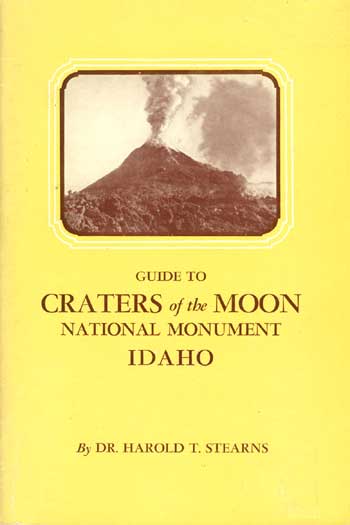
|
Idaho Bureau of Mines and Geology Bulletin
Craters of the Moon National Monument, Idaho |
CONTENTS.
Early exploration and Indian history
Fauna
Flora, by Marie McElreath
Sequence of lava flows
Prominent cinder cones
Principal caves
Important natural bridges
Tree-mold localities
Occurrences of water and ice
Index (omitted from the online edition)
ILLUSTRATIONS.
Plate
I. Sketch map of the Craters of the Moon National Monument
II. View looking southeastward from Big Cinder Butte, showing a double line of cones, many of them grass-covered, and all of them vents of numerous flows which unite southward into one great field of lava, lonely and uninhabited
III. A. A
chain of very symmetrical spatter cones marks the site of Crystal
Fissure, near the end of the automobile road
B, Round Knoll, an ancient grass-covered cinder cone, stands as a
yellow island in a sea of black lava
IV. A, A picturesque camp made by a lone geologist on the cinders of Inferno B, In the central part of the Monument the old cinder cone called The Watchman reopened and lava flowed out quietly from the northwest and southeast sides
V. A, cinder
crags, portions of cones floated away on the surface of a lava flow near
the entrance to the Monument
B, The last slop-over of lava on the slope of Big Craters Butte
at the end of the automobile road
VI. A, An
extensive billowy pahoehoe lava flow from North Crater was one of the
last eruptions in the Craters of the Moon
B, Close-up view of a cracked and fissured surface of a billowy
pahoehoe lava flow northeast of Big Cinder Butte
VII. The ropy and wrinkled surfaces of the pahoehoe are due to the hardening of a thin crust or scum on the flow while the crust is being pushed forward by the flowing lava below
VIII. A "frozen" cascade of pahoehoe east of Surprise Cave
IX. A,
Pahoehoe in places breaks up like slush ice on a river in spring
B, Entrance to Great Owl Cavern, the most perfect lava tube or
cavern in the Monument
X. A,
Entrance to Indian Tunnel, the largest and most accessible lava tube in
the Monument
B, Crescentic piles of rocks which weighted down Indian tepees
are numerous near Indian Tunnel
XI. A, The
narrow ledges parallel to the floor of Buffalo Caves are the shore lines
of a subsiding river of lava
B, The natural bridges are small remnants of the tunnel roof that
were left standing after the collapse that followed the draining away of
the lava river
XII. A few lava stalactites from the caves
XIII. A lava stalactite from the under surface of the crust of a pahoehoe lava flow in contrast to a stalactite from the roof of a lava tunnel
XIV. A, The
bridge of the Moon, showing the graceful arch of a lava tunnel
B, Dark, yawning fissures break the barren surface of Broken
Top
XV. The rough, bristling, jagged kind of lava is known as aa
XVI. A, The
most symmetrical cinder cone and crater bowl in the Monument is part of
Two Point Butte
B, A ribbon bomb "frozen" to a cinder
XVII. Some small spindle and ribbon bombs found on the cones in the Monument
XVIII. A, A
bread-crust bomb from North Crater
B. Lava pendants and gypsum crystals adorn the interior of
Crystal Pit
XIX. A, The
impressions of charred logs and the molds of the tree trunks are
preserved in some places in the pahoehoe lava
B, The Highway aa lava flow as seen from Sunset Cone
XX. The lava trees are tree molds that rise above the surface of the lava flow
XXI. Hoodoo Water Hole, in the Serrate aa lava flow, where water only 1" or 2" above the freezing point can be found on the hottest summer days
STATE OF IDAHO
H. C. BALDRIDGE, Governor
BUREAU OF MINES AND GEOLOGY
ERNEST W. ELLIS, Acting SecretaryReprinted as a Guide to Craters of the Moon National Monument Idaho
The photograph on the cover of the 1930 reprint edition is a view of a small spatter cone in the crater of Vesuvius, and illustrates how the spatter cone shown on page 10 looked when in eruption.©Copyright 1930
By Harold T. Stearns
The Caxton Printers, Ltd.
Caldwell, Idaho
First Printing, July, 1930
Second Printing, April, 1936
Third Printing, January, 1941
Fourth Printing, September, 1951
Fifth Printing. November, 1955
Sixth Printing, September, 1959
| <<< Previous | <<< Contents >>> | Next >>> |
id/1928-13/contents.htm
Last Updated: 28-Mar-2006
